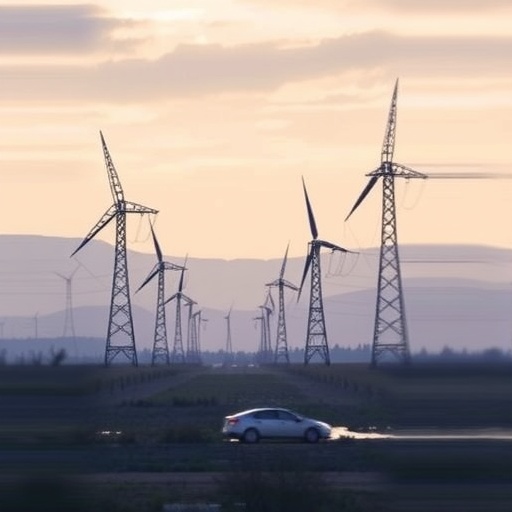Recent groundbreaking research reveals that regional coordination could be a game-changer in reducing the enormous financial burdens associated with transitioning to a low-carbon electricity system. As nations worldwide intensify their commitments to slash greenhouse gas emissions, the electrical grids that power modern life face unprecedented challenges. The new study, published in Nature Communications, provides compelling evidence that cooperative frameworks extending across geographic regions may drastically lower overall system costs, enabling a more feasible and resilient renewable energy future.
The world’s electricity systems are undergoing a profound transformation, driven by the urgent need to pivot from fossil fuels towards renewable sources such as wind and solar power. Unlike traditional power plants, these renewable sources are inherently intermittent, fluctuating with weather and daylight. This variability demands sophisticated solutions to ensure supply meets demand reliably at all times. In large part, these solutions implicate energy storage technologies, grid infrastructure upgrades, and flexible generation assets, all of which come with considerable expenses.
Conventional approaches often treat national or sub-national energy systems as isolated entities, optimizing each grid with localized resources and demand profiles. While this may simplify policy and management, it can inadvertently lead to duplicated investments and inefficient use of renewable resources. The newly published research illustrates how expanding the scale of coordination beyond these confines—across wider regional networks—can unlock synergies that reduce the overall need for expensive infrastructure and storage solutions.
By pooling renewable energy generation and demand across multiple interconnected regions, variability can be smoothed out more effectively. For example, when sunlight diminishes in one area, wind power in a neighboring region might compensate. This spatial balancing effect significantly lowers the amount of redundant capacity and storage necessary to guarantee reliability, translating directly to cost savings. The study’s authors employed cutting-edge modeling techniques to simulate various levels of grid integration and renewable build-out scenarios.
Their results demonstrate that even partial regional coordination yields substantial reductions in total system costs compared to isolated planning. The cost savings increase further as the degree of infrastructure integration intensifies, revealing strong economies of scale and improved utilization of renewable resources. Importantly, these benefits persist across different technological assumptions and demand growth projections, highlighting the robustness of the findings.
Beyond economic advantages, regional coordination enhances system flexibility and resilience. By leveraging geographic diversity, regions can better withstand localized weather events, equipment failures, or demand surges without compromising overall grid stability. This distributed reliability is crucial as climate change increases the frequency and severity of extreme weather patterns that threaten energy infrastructure.
However, achieving effective regional coordination entails navigating complex institutional, regulatory, and political challenges. Electricity markets, grid codes, and governance structures vary widely across jurisdictions, often creating barriers to seamless cooperation. The authors emphasize the necessity for harmonized policies, standardized technical protocols, and transparent market mechanisms that incentivize cross-border collaboration and investments in shared infrastructure.
The study also highlights the importance of advanced grid planning tools capable of modeling high spatial and temporal resolution data. Incorporating detailed weather patterns, load forecasts, and generation profiles enables optimizing renewable deployment and transmission expansion strategies at scale. These innovations empower system operators and planners to make data-driven decisions that balance cost, reliability, and environmental goals effectively.
Moreover, the research underscores the role of emerging technologies such as large-scale energy storage, demand response, and power electronics in facilitating regional coordination. Storage systems can buffer short-term imbalances, while demand-side flexibility allows shifting consumption to align better with renewable availability. Power electronics enable dynamic control of power flows across grid interfaces, supporting efficient energy exchanges between regions.
Importantly, the benefits of regional coordination accrue not only to wealthy or developed areas but also extend to energy-poor or developing regions. Shared infrastructure investments can lower barriers to renewable energy adoption, promote equitable access, and support broader economic development. Transnational cooperation around electricity infrastructure thus presents an opportunity for inclusive progress towards decarbonization.
Looking at the policy landscape, the findings offer actionable insights for governments, regulators, and industry stakeholders aiming to accelerate clean energy transitions. By prioritizing regional grid interconnections and joint planning frameworks, decision-makers can unlock cost-effective pathways that simultaneously enhance sustainability and energy security. These strategies align with international climate targets while mitigating the social and economic trade-offs of system upheaval.
The study’s comprehensive analysis contributes to a growing body of evidence advocating for integrated energy systems. It challenges fragmented approaches and advocates for a holistic vision that treats electricity grids as interconnected ecosystems spanning regions and nations. Embracing this paradigm shift will be critical to overcoming the technical, economic, and political hurdles on the path to a fully renewable energy future.
While the research clarifies the profound advantages of regional coordination, it also calls for continued innovation and interdisciplinary collaboration. Advancements in grid technologies, market designs, and regulatory frameworks must evolve hand in hand to realize the full potential of interconnected low-carbon systems. Moreover, ongoing stakeholder engagement and public acceptance are pivotal to building trust and momentum for cooperative approaches.
In conclusion, this groundbreaking study from Wessel, Chowdhury, Wild and colleagues illuminates a promising strategy to alleviate the enormous cost pressures of transitioning to a low-carbon electricity system. Through enhanced regional coordination, the pathway to a renewable-powered future becomes more affordable, resilient, and equitable. As nations strive to meet climate ambitions, embracing cross-border collaboration in electricity systems may well be the linchpin for success—and a beacon of hope amidst the climate crisis.
—
Subject of Research:
Article Title:
Article References:
Wessel, J., Chowdhury, A.K., Wild, T. et al. Regional coordination can alleviate the cost burden of a low-carbon electricity system. Nat Commun 16, 9033 (2025). https://doi.org/10.1038/s41467-025-64093-8
Image Credits: AI Generated




